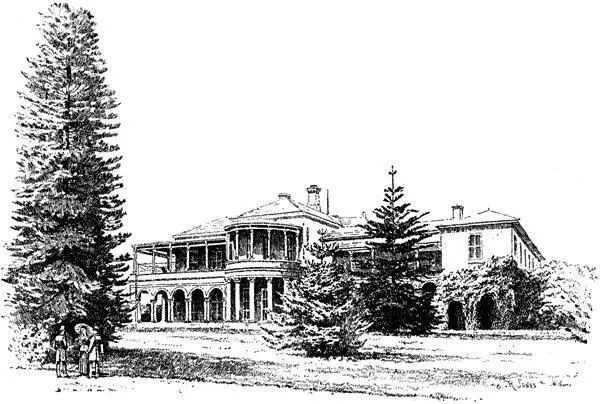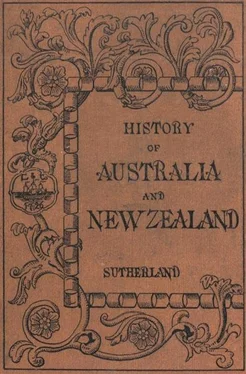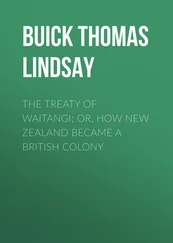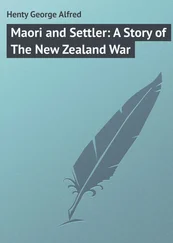11. Present State of the Colony.—In 1868 Sir George Bowen was sent to govern New Zealand, and Governor Blackall took charge of affairs in Queensland. He was a man of fine talents, and amiable character, and was greatly respected by the colonists; but he died not long after his arrival, and was succeeded by the Marquis of Normanby, who, in his turn, was succeeded, in 1874, by Mr. Cairns. Sir Arthur Kennedy, in 1877, Sir Anthony Musgrave, in 1883, Sir Arthur Hunter Palmer, in 1888, and General Sir H. Wylie Norman bring the list of Governors to the present year (1894).
Queensland possesses magnificent resources, which have only recently been made known, and are now in process of development. Her exports of gold exceed two million pounds a year; she produces large quantities of tin, copper, silver, and other minerals. The wool clipped from her sheep exceeds one million four hundred thousand pounds in annual value; and her total exports, including cotton, sugar, and other tropical productions, amount to about six million pounds per annum. The population is now about half a million, and immigrants continue to arrive at the rate of about sixteen thousand a year. Though the youngest of the Australian colonies, Queensland now ranks fourth on the list, and appears to have a most promising future before her. Her cotton industry has almost vanished, and her sugar plantations have passed through troublous times, but there seem to be good hopes for them in the future. However, it will be in the raising of sheep and of cattle, as well as in gold-mining, that the colony will have to look for her most permanent resources. She has now nearly twenty million sheep and six million cattle, and sends wool, tallow, hides, and frozen meat to England, while she supplies prime bullocks for the Melbourne Market.
12. The Aborigines.—Australian history practically begins with the arrival of the white man, for before that time, though tribe fought with tribe and there were many doings of savage men, there is nothing that could be told as a general story. Each tribe of from twenty to a couple of hundred dusky forms wandered over the land, seeking animals to hunt and fresh water to drink. They were very thinly spread, not more than one person to ten square miles, yet every little tribe was at deadly feud with its neighbour.

Government House, Brisbane.
The tribe wandered over the grassy and park-like lands, the men stalking ahead with spears and boomerang in hand; the women trudging behind loaded with babies, and utensils. At evening they camp and the men put up frail break-winds, consisting of a few branches and leafy tufts; behind this on the sheltered side a few leaves made a bed. Meantime the fire was lit close by, and soon a dozen little columns of blue smoke curl up among the trees. The opossum, or duck, or wallaby is soon cooked or half-cooked; the men devour as much as they want and pass on the remains to the women and children. A frog or two and a lizard, or a few grubs taken out of decayed timber, or perhaps a few roots that have been dug up on the march by the women, form a sort of dessert. After dusk there is the sound of chatter round the fires; then all retire to rest, with the glowing embers of the fires to give them warmth. At daybreak all are awake. If there is food at hand they may stay in the same camp for weeks together, but if not they journey on.
Each man had as many wives as he could obtain. He did not support them, but they supported him, and when children became too numerous he lessened his family by killing off a few. More than half the children were thus destroyed. Their enjoyments consisted of games with a kind of ball, and mock-fights, but especially in a wild dance they called the corrobboree. They were in general good-humoured when things went pleasantly; but a man would spear his wife through the leg or dash his child’s brains out readily enough when things were not to his taste, and nobody would think any the worse of him for it.
CHAPTER XVII.
EXPLORATIONS IN THE INTERIOR, 1840-1860.
1. Progress of Exploration.—The coasts of Australia had all been examined before the year 1815. From that date those who wished to make fresh discoveries were obliged to penetrate into the interior; and we have already seen that, previous to the year 1836, explorers were busy in opening up the south-east portion of the continent. Oxley had made known the northern districts of New South Wales, and Allan Cunningham the southern part of what is now the colony of Queensland. Hume and Hovell, Sturt and Mitchell, had traversed the southern districts of New South Wales and the territory now occupied by Victoria. Following closely in the footsteps of these intrepid discoverers, the squatters had entered all these districts, and, wherever the land was suitable, had settled down with their flocks; so that, ere long, all that corner of Australia which would be cut off by drawing a straight line from Brisbane to Adelaide was fully surveyed. But there still remained to be explored about seven-eighths of the continent; and from this date onward there was an unbroken succession of adventurous travellers, who entered the vast central territory for the purpose of making known its nature and capacities. But the manner of conducting an expedition was now very different from what it had been. Previous explorers had been provided with parties of convicts, and had traversed lands for the greater part grassy and well watered. These expeditions had their dangers, arising chiefly from the hostility of the blacks; and Allan Cunningham, his brother Richard, with many others, sacrificed their lives in their ardour for discovery. But subsequent travellers had to encounter, in addition, the pangs of hunger and thirst in that dry and desolate country which occupies so great a portion of Central Australia.
2. Eyre.—The first on this roll of gallant discoverers was Edward John Eyre, who, in 1840, offered to conduct an expedition to the interior. He himself provided about half the money required, the South Australian Government—which was then in difficulties—gave a hundred pounds, and a number of Eyre’s personal friends made up the remainder. With five Europeans, three natives, and thirteen horses, and with forty sheep to serve as food on the way, he set out from Adelaide and travelled to the head of Spencer’s Gulf, where a small vessel lay waiting to supply them with provisions sufficient for three months. Having traversed forty or fifty miles of desert land, he turned to the west, and came in sight of what he called Lake Torrens. It was now dried up, so that in place of a sheet of water twenty miles broad, he saw only a dreary region covered with glittering salt. When he entered upon it the thin crust of salt broke, and a thick black mud oozed up. The party plunged onward for about six miles, the mud becoming always deeper and deeper, till at length it half covered the saddles of their horses. He was then forced to turn back, and to seek a passage round this lake of mud; but, having followed its shores for many miles, there seemed to be so little prospect of reaching the end of the obstacle, that he turned his course again, from west to north. After travelling about two hundred miles through a very desolate country, he was once more arrested by coming upon a similar sheet of salt-encrusted mud, which he called Lake Eyre. Again there appeared no hope of either crossing the lake or going round it; no water was to be found, and his supplies were fast failing, so that he was forced to hasten back a long distance to the nearest stream. Setting out once more, he twice attempted to penetrate westward into the interior, but, on each occasion, the salt lakes barred his progress, and as a last effort he urged his failing party towards the north-east. Here the country was the most barren and desolate that can be imagined. It was not always so, but after a period of drought, when the grass is burnt to the roots and not a drop of fresh water to be seen in a hundred miles, it has all the appearance of a desert. His supplies of water ran short, and frequently the explorers were on the point of perishing. When they approached the Frome River—a creek which flows northwards into Lake Eyre—they were inexpressibly delighted to view from afar the winding current; but its waters were found to be as salt as the ocean. After a long and dreary journey, Eyre ascended a hill, in order to see if there was any hope of finding better country; but the view was only a great and barren level, stretching far away to the horizon on every side. He had now no water, and his only course was to turn back; so, leaving this place—which he called Mount Hopeless—he retraced his steps to the head of Spencer’s Gulf.
Читать дальше













